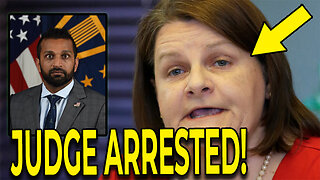Premium Only Content

Only San Diego U.S.A. Anniversary Parade Branches of the Armed Forces (Very Sad ?)
The History of Armed Forces Day On Aug. 31, 1949, Defense Secretary Louis Johnson announced the creation of an Armed Forces Day to replace separate Army, Navy and Air Force Days. The single-day celebration stemmed from the unification of the armed forces under one agency -- the Department of Defense.
In a speech announcing the creation of the day, President Truman "praised the work of the military services at home and across the seas." He said, "It is vital to the security of the nation and to the establishment of a desirable peace."
In an excerpt from the Presidential Proclamation of Feb. 27, 1950, Truman stated:
"Armed Forces Day, Saturday, May 20, 1950, marks the first combined demonstration by America's defense team of its progress, under the National Security Act, toward the goal of readiness for any eventuality. It is the first parade of preparedness by the unified forces of our land, sea, and air defense."
Armed Forces Day Themes
Each year, Armed Forces Day has a new theme. The very first theme was "Teamed for Defense."
Over the years, other themes have included Appreciation of a Nation; Arsenal of Freedom and Democracy; Dedication and Devotion; Deter if Possible, Fight if Necessary; Freedom; Freedom Through Unity; Guardians of Peace; Lasting Peace; Liberty; and Patriotism.
How to Celebrate Armed Forces Day
The first Armed Forces Day was celebrated by parades, open houses, receptions, and air shows. In Washington, D.C., 10,000 troops of all branches of the military, cadets and veterans marched past the president and his party. In Berlin, 1,000 U.S. troops paraded for the German citizens at Tempelhof Airfield. In New York City, an estimated 33,000 participants initiated Armed Forces Day "under an air cover of 250 military planes of all types."
Today, Armed Forces Day is celebrated in American communities and on military bases throughout the world with parades, picnics, shopping discounts, festivals and parties.
Stay Up-to-Date With Military Discounts
Want the scoop on military discounts? From travel to phones and everything in between, troops, military families and veterans can stay on top of military discounts.
Armed Forces Day 2021 will be celebrated on Saturday, May 15th. This holiday pays tribute to men and women who serve across all six branches in the United States military. Read on to find out more about the history of this observance and see suggested searches and related resources.
Armed Forces Day Historical Timeline
July 26, 1947 – President Harry S. Truman signed the National Security Act into law (*Statute Compilation, codified in Title 50 of the U.S. Code: War and National Defense). This Act unified the four branches of the military under a single executive authority, the Secretary of Defense. This decision led to the creation of the National Military Establishment.
August 31, 1949 – Secretary of Defense Louis Johnson announced Armed Forces Day as a unification of the separate Army, Navy, Marine Corps, and Air Force celebrations, a reflection of the unification of the forces under the National Security Act. Armed Forces Day was intended to replace the separate days of celebration, but some branches maintain their own celebration in addition to the joint observance. (Source: Defense.gov ) Read remarks from Senator Lodge on Secretary Johnson's announcement as printed in the Congressional Record on April 7, 1949.
February 27, 1950 – The first Armed Forces day was proclaimed by Presidential Proclamation 2873, but not observed until May that year. President Truman declared, "Armed Forces Day, Saturday, May 20, 1950, marks the first combined demonstration by America's defense team of its progress, under the National Security Act, towards the goal of readiness for any eventuality. It is the first formal procession of preparedness by the unified forces of our land, sea, and air defense."
May 20, 1950 – Armed Forces Day is first celebrated.
U.S.A. Anniversary Parade And People's Celebrations Presided Over Branches of the Armed Forces Day (Very Sad) Sorry Very Hard Find Parade (World Is Laugh At US) ?
The history of the U.S. Armed Forces dates back to 14 June 1775, with the creation of the Continental Army, even before the Declaration of Independence marked the establishment of the United States. The Continental Navy, established on 13 October 1775, and Continental Marines, established on 10 November 1775 were created in close succession by the Second Continental Congress in order to defend the new nation against the British Empire during their American Revolutionary War. In 1982 Air Force Space Command was established as its first operational space command and has continued to grow over time as DOD sought to consolidate its forces.
What is the U.S. Space Force and what does it do? The Space Force motto, "Semper supra," is Latin for "Always above," a phrase that encapsulates the service's mission. The United States Space Force was established as the sixth and newest branch of the U.S. Armed Forces on Dec. 20, 2019 when the National Defense Authorization Act was signed into law. Before that, the United States hadn't created a new military branch since 1946, when it stood up the Air Force.
The push for a dedicated branch of the armed services devoted to the final frontier gained steam as orbital space became increasingly crowded and contested. As the United States' critical infrastructure became increasingly dependent on satellites for communication, navigation, meteorology and intelligence, the U.S. Department of Defense likewise identified a need for a branch of the military dedicated solely to operating and protecting these assets. Thus, Space Force was created.
The service's motto, "Semper supra," is Latin for "Always above," a phrase that encapsulates the Space Force's mission. Its symbol, the Delta, signifies the service's responsibilities and mission while honoring its long history that began long before the Space Force was created in 2019.
The history of the U.S. Space Force dates back to 1954 when the U.S. Air Force created a division tasked with overseeing the U.S. military's ballistic missiles. This division evolved several times throughout the following decades and merged with other organizations as the United States began placing more satellites in orbit for communications and early missile warning systems. In 1982, the Air Force stood up Air Force Space Command, making it the first operational space command in the U.S. Armed Forces. Air Force Space Command continued to grow from the 1980s onward as the Department of Defense (DOD) sought to consolidate its space operations.
On Dec. 20, 2019, Air Force Space Command was renamed United States Space Force and was established as an independent service when President Donald Trump signed the 2020 National Defense Authorization Act, the laws overseen by the U.S. Congress that authorize annual military expenditures. Under the structure signed into law, Space Force would be part of the U.S. Department of the Air Force, in much the same way that the United States Marine Corps is part of the U.S. Department of the Navy.
At its creation, 16,000 military and civilian personnel were assigned to the Space Force. As of January 2023, the service consists of 4,286 enlisted service members and 4,314 officers, according to the Air Force Times(opens in new tab), making it the smallest branch of the U.S. military. The U.S. Navy, by comparison, has well over 300,000 active duty members, while the U.S. Army boasts close to 500,000 active service members.
Space Force service members are known as Guardians, a name announced in a 2020 ceremony marking the service's first anniversary. The service's service dress uniforms were debuted in a Sept. 2021 ceremony, revealing them to be a six-button double-breasted tunic that drew comparisons(opens in new tab) to the costumes worn in the sci-fi series "Battlestar Galactica."
According to the U.S. Space Force's mission statement(opens in new tab), the service is responsible for "organizing, training, and equipping Guardians to conduct global space operations that enhance the way our joint and coalition forces fight, while also offering decision-makers military options to achieve national objectives."
To accomplish this mission, Space Force is organized into three main divisions: Field commands, Deltas and squadrons. The service's three field commands are Space Operations Command (SpOC), Space Systems Command (SSC) and Space Training and Readiness Command (STARCOM). Field commands oversee broad mission goals.
Space Operations Command, for example, is responsible for providing "combat ready" space capabilities, cyber operations and intelligence in support of U.S. military operations, according to a SpOc fact sheet(opens in new tab).
Space Systems Command, meanwhile, is responsible for the service's development and acquisition of new space technologies and capabilities. The command's website(opens in new tab) writes that SSC is tasked with "developing, acquiring, equipping, fielding and sustaining lethal and resilient space capabilities for warfighters." This mission includes overseeing launch operations and on-orbit maintenance of DOD satellites and other space systems.
Space Training and Readiness Command, or STARCOM, as its name suggests, is tasked with educating and training Space Force personnel "to fight and win in a contested, degraded, and operationally limited environment through the deliberate development, education and training of space professionals; development of space warfighting doctrine, tactics, techniques, and procedures; and the test and evaluation of USSF capabilities," according to its website(opens in new tab).
Within each field command are various Space Force Deltas. Deltas have a much more specific function, such as operations, training or facility support, according to a 2020 Space Force statement(opens in new tab). For example, Space Launch Delta 45(opens in new tab) (SLD 45) at Cape Canaveral Space Force Station in Florida is tasked with overseeing all space launch operations from the U.S. East Coast, including from Cape Canaveral Space Force Station. SLD 45 manages the Eastern Range, a massive rocket range that stretches out over the Atlantic Ocean into the Indian Ocean, and provides launch support for the DOD, NASA and private space launch providers.
Each Delta is further divided into squadrons, each tasked with a specific purpose that supports the overall mission of its respective field command. The 45th Weather Squadron(opens in new tab), for example, is part of Space Launch Delta 45 at Patrick Space Force Base in Florida and is responsible for performing weather observations and making forecasts in support of launch operations at Cape Canaveral Space Force Station and NASA's Kennedy Space Center.
These squadrons, Deltas, and field commands work together to ensure that the Space Force can protect U.S. space assets as Earth orbit becomes increasingly contested. In recent decades, the United States' peer adversaries such as China and Russia have advanced their own space capabilities to the point where U.S. satellites are under attack daily, according to U.S. Space Force Gen. David Thompson, then vice chief of space operations. Thompson told The Washington Post(opens in new tab) in 2021 that "threats are really growing and expanding every single day. And it's really an evolution of activity that's been happening for a long time," adding that "we're really at a point now where there's a whole host of ways that our space systems can be threatened."
More recent statements by U.S. Space Force leadership echo this same sentiment. Gen. B. Chance Saltzman, the branch's chief of space operations, said at the Reagan National Defense Forum in Simi Valley, California in December 2022 that protecting United States capabilities in space has become one of the Pentagon's top priorities, SpaceNews reported(opens in new tab). "The capability that space offers has demonstrated its value so much so that both sides are engaged in trying to counter those capabilities and deny those advantages to the opponent," Saltzman said. Space is "clearly a contested domain," he added.
The ways in which satellites and other spacecraft can be threatened or countered range from reversible, non-damaging capabilities on one end such as jamming GPS transmission or using lasers to blind satellites' optical sensors, to the other end that includes destructive anti-satellite missiles, tests of which have drawn condemnation from the international community.
The U.S. Space Force has units tasked with tracking these threats and engaging in "on-orbit combat," although the exact capabilities of these units remain classified — as do many of the service's assets and technologies.
The U.S. Space Force systems and capabilities that are unclassified and known to the public include (but are not limited to) the Global Positioning System (GPS), overseen by Space Delta 8 at Schriever Space Force Base in Colorado; the Defense Meteorological Satellite Program(opens in new tab) (DMSP) that provides weather data to the U.S. military; and a wide variety of intelligence, surveillance and missile early warning systems like the Next Generation Overhead Persistent InfraRed(opens in new tab) system (Next-Gen OPIR), Space Based Infrared System (SBIRS) program and the Space Tracking and Surveillance System.(opens in new tab)
Space Force also tracks objects from low Earth orbit all the way to deep space using a variety of ground-based sensors like the Ground-Based Electro-Optical Deep Space Surveillance(opens in new tab) (GEODSS) system.
Perhaps most well-known of all Space Force assets is the X-37B, the Boeing-built space plane whose missions remain largely mysterious despite many high-profile long-duration flights in orbit.
Since the creation of the Space Force, the service has largely turned to commercial launch providers to loft its satellites and other assets to orbit. Since 2020, ULA and SpaceX have been the exclusive launch providers for the U.S. Space Force, although the service is looking to partner with more providers from 2023 onward, according to Space News(opens in new tab).
Today, U.S. Space Force operates six dedicated Space Force bases, two of which host orbital launches for the service's many satellites and spacecraft. These include:
Buckley Space Force Base(opens in new tab), Aurora, Colorado
Los Angeles Air Force Base(opens in new tab), El Segundo, California
Patrick Space Force Base(opens in new tab), Brevard County, Florida
Peterson Space Force Base(opens in new tab), Colorado Springs, Colorado
Schriever Space Force Base, Colorado Springs, Colorado
Vandenberg Space Force Base(opens in new tab), Santa Barbara County, California
Vandenberg Space Force Base is home to Space Launch Delta 30(opens in new tab), which oversees the Western Range and manages launch activities for the DOD, NASA and private space firms. The Western Range stretches from the West Coast of the United States into the Indian Ocean, where it meets the Eastern Range.
In addition to these Space Force bases, the service operates eight Space Force stations, which include:
Cape Canaveral Space Force Station, Cape Canaveral, Florida
Cape Cod Space Force Station, Bourne Massachusetts
Cavalier Space Force Station, Cavalier, North Dakota
Cheyenne Mountain Space Force Station, Colorado Springs, Colorado
Clear Space Force Station, Clear, Alaska
Kaena Point Space Force Station, Honolulu County, Hawaii
New Boston Space Force Station, New Boston, New Hampshire
Thule Air Base, Qaanaaq, Greenland
Cape Canaveral Space Force Station is home to Space Launch Delta 45 and oversees launches for a variety of space agencies and companies, including NASA's Kennedy Space Center. During the historic launch of NASA's Artemis 1 mission to the moon in November 2022, for example, SLD 45 oversaw radar tracking of the agency's SLS mega moon rocket over the Eastern Range.
The silver outline of the delta represents the service's commitment to protecting U.S. space assets from adversaries and threats. In the center, a symbol representing the North Star, Polaris, represents the core values that guide Space Force, in much the same way the North Star has guided travelers for millennia.
Alongside the North Star are four triangular elements that represent four branches of the U.S. Armed Forces: the Army, Air Force, Navy and Marines. Finally, in the top of the delta symbol are two bright lines representing a rocket launching into orbit. This element symbolizes the central role of Space Force in overseeing launch operations on behalf of the Pentagon.
United States Space Force History, [Accessed 01/31/23]
https://www.spaceforce.mil/About-Us/About-Space-Force/History/(opens in new tab)
United States Space Force Locations, [Accessed 01/31/23]
https://www.spaceforce.mil/About-Us/Space-Force-Locations/(opens in new tab)
What's the Space Force?, [Accessed 01/31/23]
https://www.spaceforce.mil/About-Us/FAQs/Whats-the-Space-Force/(opens in new tab)
New in 2023: Saltzman leads Space Force into its 4th year, [Accessed 01/31/23]
https://www.airforcetimes.com/news/your-air-force/2023/01/03/new-in-2023-saltzman-leads-space-force-into-its-4th-year/(opens in new tab)
Beyond Space Horizons: A Half Century of Air Force Space Leadership, [Accessed 01/31/23]
https://apps.dtic.mil/sti/citations/ADA355572(opens in new tab)
About Space Operations Command, [Accessed 01/31/23]
https://www.spoc.spaceforce.mil/About-Us/About-Space-Operations-Command(opens in new tab)
About Space Systems Command, [Accessed 1/31/23]
https://www.ssc.spaceforce.mil/About-Us/About-Space-Systems-Command(opens in new tab)
Space Training and Readiness Command: Who We Are, [Accessed 1/31/23]
https://www.starcom.spaceforce.mil/About-Us/Who-We-Are/
Democratic Caucus, issued the following statement on Veterans Day:
“As we honor those who served our country, we must pay special thanks to our LGBTQ veterans who served with distinction, and often under circumstances that could have ended their careers. We must ensure visibility and recognition for our LGBTQ veterans.
“Sadly, we do this at a time when the Trump administration is methodically trying to erase our transgender service members. Those who choose to serve in the military do so to fight for the American ideals of freedom and equality not only around the world, but also here at home. Thank you for your service, and know that the American people will always stand for equality.”
A country’s military is one of its most important assets. The military works for the government and is tasked with enforcing domestic and foreign policies and protecting that country's citizens. Some nations have mandatory military service in which every citizen must serve for at least a certain number of years.
Factors to consider when evaluating a country's military strength
There are several crucial factors to consider when analyzing the strength of a nation’s military. The capability and availability of equipment (vehicles, weaponry, communications gear, etc.) is essential. The quality of training each soldier receives is vital. Their commanders' ability to consistently devise effective tactical strategies can be pivotal. But one of the most fundamental measures of a country's military strength is the number of soldiers it can deploy.
The list of countries that boast the highest total (active duty, reserves, and paramilitary) number of members in the military may be surprising to some readers. However, it is vital to also keep in mind servicepeople are usually divided into three categories: soldiers on active duty, reserves, or paramilitary members.
Soldiers on active duty — Soldiers who work for the military full time, often live on base, and may be deployed at any time.
Reservists — Soldiers who typically serve part time and join the reserves—such as the Army Reserve or National Guard—to make extra money, get tuition bonuses at college/university, or take advantage of other perks without devoting themselves full time to the military.
Paramilitary members — Servicepeople who belong to organizations such as Canada’s Canadian Rangers or France's National Gendarmerie, which are military-like, but not formally part of the armed forces.
North Korea dominates the list in terms of military members per capita, with 306.1 total members and 50.4 active members per capita. For comparison, the next closest countries in those categories are South Korea with 130.5 total per capita and Eritrea with 33.8 total active members per capita. However, these numbers can be deceiving, as the overwhelming majority of soldiers in Vietnam, North Korea, and South Korea are reserves or paramilitary, not active duty. In terms of the total number of active military members, there are eight nations with active militaries exceeding 500,000 soldiers:
Top 10 Countries with the Highest Number of Active-Duty Military Personnel (in members):
China: 2,185,000
India: 1,455,550
United States: 1,388,100
North Korea: 1,280,000
Russia: 1,014,000
Pakistan: 654,000
Iran: 610,000
South Korea: 599,000
Vietnam: 482,000
Egypt: 438,500
It is noteworthy that the world's three most populous countries also have the three largest standing armies, and in the same order. China's massive force is the largest, followed by India and the United States. While the United States has the third-highest population in total, the third-highest number of active military members, and the fourth-highest number of military members overall, it has the highest military spending of any country in the world. Once reserve members are added in, Vietnam's military becomes the largest, with roughly 5 million people in its reserves. The Republic of Korea also has 3.1 million members in its military reserves.
Top 10 Countries with the Highest Number of Active-Duty and Reserve Military Personnel (in members):
Vietnam: 5,482,000
South Korea: 3,699,000
China: 3,355,000
Russian Federation: 3,014,000
India: 2,610,550
United States: 2,233,050
North Korea: 1,880,000
Taiwan: 1,820,000
Brazil: 1,706,500
Pakistan: 1,204,000
Looking strictly at each nation's paramilitary capabilities, the ranking again changes. The nation with the largest paramilitary is the Democratic People’s Republic of Korea (North Korea), which has over 5.889 million members. Conversely, the United States does not count paramilitary organizations as part of its available military (though some, such as the Civil Air Patrol, are considered auxiliaries), so its paramilitary officially has zero members.
Top 10 Countries with the Highest Number of Paramilitary Personnel (in members):
North Korea: 5,889,000
Vietnam: 5,000,000
South Korea: 3,013,500
India: 2,526,950
Cuba: 1,146,500
China: 660,000
Russia: 554,000
Egypt: 397,000
Brazil: 395,000
Pakistan: 291,000
On the other side of the coin, some nations have no active military members, or their militaries are minimal. The following six nations have no active members of the military: Costa Rica, Iceland, Libya, Marutius, Palestine, and Panama. For a full table of countries and their military headcounts, see below.
Top 10 Countries with the Highest Number of Active-Duty Military Personnel (in members):
China - 2.2M
India - 1.5M
United States - 1.4M
North Korea - 1.3M
Russia - 1M
Pakistan - 654K
Iran - 610K
South Korea - 599K
Vietnam - 482K
Egypt - 438.5K
The world’s most powerful countries also are the ones that consistently dominate news headlines, preoccupy policymakers and shape global economic patterns. Their foreign policies and military budgets are tracked religiously. When they make a pledge, at least some in the international community trust they will keep it. These countries project their influence on the world stage.
-
 14:33
14:33
What If Everything You Were Taught Was A Lie?
22 days agoSo Democrats Party Tried A Coup To Overthrow US Government Working With Human Traffickers
2.8K2 -
 LIVE
LIVE
The Jimmy Dore Show
3 hours agoLiz Warren CAN’T DEFEND Lying About Biden! Trump Tells Putin to STOP bombing Ukraine! w/Neil Oliver
13,236 watching -
 1:45:26
1:45:26
vivafrei
4 hours agoSantos Sentenced to 87 MONTHS! Corrupt Judges ARRESTED! Some Canada Stuff & MORE!
77.6K54 -
 LIVE
LIVE
Nerdrotic
4 hours ago $7.71 earnedStar Wars GRAPED? Hollywood In Freefall, Silver Surfer is a MAN! | Friday Night Tights 351
4,749 watching -
 LIVE
LIVE
Dr Disrespect
7 hours ago🔴LIVE - DR DISRESPECT - PUBG - 5 CHICKEN DINNERS CHALLENGE
5,711 watching -
 LIVE
LIVE
Keepslidin
16 minutes ago$5000 START | ROAD TO 100K | Mother.land
9 watching -
 LIVE
LIVE
2 MIKES LIVE
2 hours ago2 MIKES LIVE #210 Open Mike Friday!
182 watching -
 13:18
13:18
T-SPLY
8 hours agoFBI Arrest Democrat Judge For Protecting Illegal Immigrant!
31.2K47 -
 UPCOMING
UPCOMING
Mally_Mouse
19 hours agoLet's Play!! -- More Dreamlight Valley!
570 -
 1:36:46
1:36:46
RiftTV/Slightly Offensive
4 hours ago $5.91 earnedTrump SHUTS DOWN War with Iran! Bibi IN RAGE | Guest: Joel Webbon | The Rift Report
38.5K21